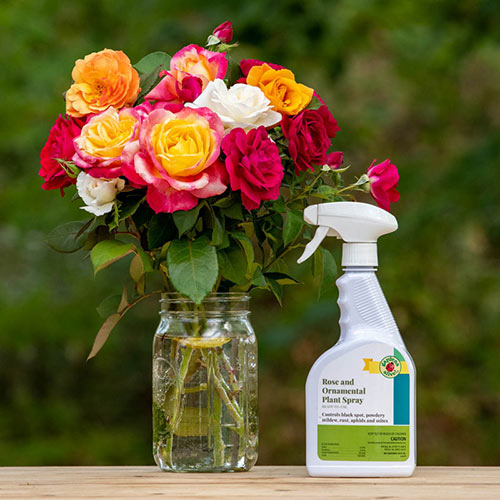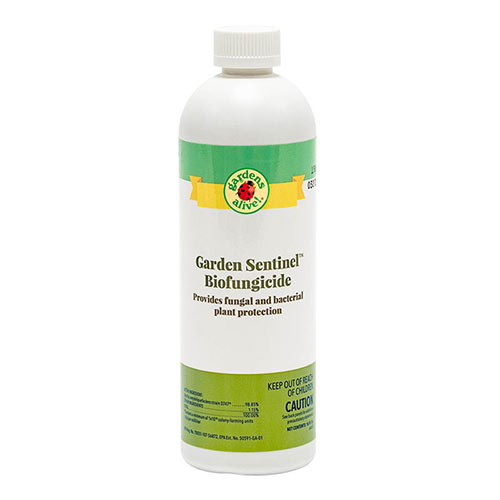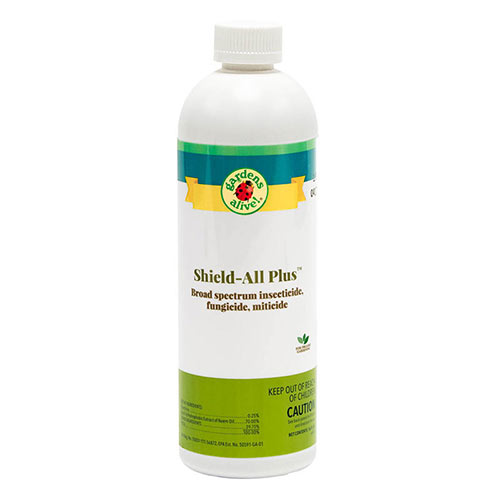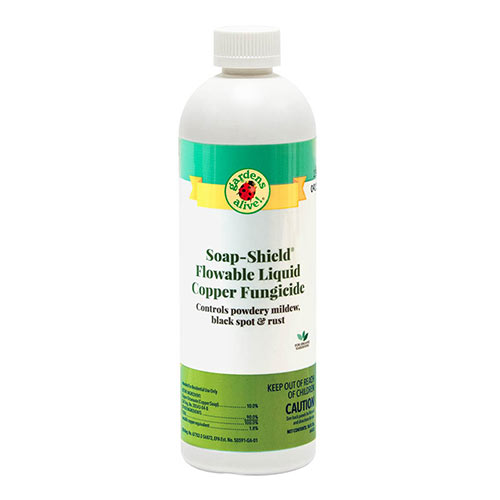What Happens When You Handle Wet Plants?
-
Helpful Products from Gardens Alive!
-
 Rose & Ornamental Plant Spray
Rose & Ornamental Plant Spray -
 Garden Sentinel™ Organic Broad-Spectrum Biofungicide
Garden Sentinel™ Organic Broad-Spectrum Biofungicide -
 Shield-All Plus™ Pest & Disease Control
Shield-All Plus™ Pest & Disease Control -
 Soap-Shield® Flowable Liquid Copper Fungicide
Soap-Shield® Flowable Liquid Copper Fungicide
Q. Kevin in Northern Kentucky "about 20 minutes south of Cincinnati" writes: "I've learned a lot from your show and was hoping you could set my overactive mind at ease. It's crunch time in the garden, and I'm eager to be out there whenever I get a chance. I heard or read or imagined that I heard or read somewhere that if you work in your garden after a heavy rain, you could be spreading disease around. But I need to pinch the suckers from my tomatoes! Should I stay or should I go?"
A. The Clash knew the answer Kev: "If you go there will be trouble. But if you stay it will be double." It is NEVER a good idea to handle wet leaves of any kind (unless you don't care for the plant in question). When leaves are wet, they become much more open to their surroundings, especially in the morning. Plants can absorb water (including dew [NOT Mountain Dew]) with the greatest efficiency in the morning. In the morning, the roots will take up the maximum amount of water, and with most plants on a dewy morning, so will the leaves. Later in the heat of the day, the water-absorbing pores on the leaves are closed up tight so they can hold onto whatever moisture they have. (That's why middle-of-the-day-watering is a waste.)
Handling: When plants are wet, their cellular structure is much more fragile. It has to be for the plants to make maximum use of the available moisture. If you handle those now-fragile wet leaves, the cells will rupture and the leaves will go all blahooey. (Yes--that's an actual horticultural term. At least on this show.) Handling any plant when its wet is never a good idea, but the danger is greatest with certain plants, like these drama queens:
The Big Five of Moisture Sensitive Plants:
• Tamatas. The original tomatoes appeared at the base of a snow-covered mountain in Peru. Moisture from snow melt was constant, but the actual plants grew out into a desert. Thus America's Gateway Drug of Gardening wants constant moisture at the root zone and bone dry leaves. Good luck with that. Handling tomato plants when wet is a sure way to be buying your sandwich-soakers at a farmer's market that summer.
• Roses. The-most-popular-flower-in-America has a rep for being pissy, but that's mostly because people treat them so poorly. Like tamatas, many of our most popular roses were found in desert-like (or just plain 'desert') conditions. Their DNA cries out for dry leaves, lots of sun and no disease-feeding wood mulch. If you're in a wet area, you can compensate for some of the unwanted moisture in your environment by mulching with compost and providing lots of airflow. Conversely (like my newly acquired classic Chuck Taylor All-Stars!) wood mulch, crowding and handling wet leaves = dead roses or roses you wish were dead.
• Lilacs. Lilacs want dry leaves, a lot of open space at the base, a mulch of compost and for you to go to the South of France for the Spring where you can't hurt them. What's that? You won't see the blooms? Big deal. Ask your friends to take pictures.
• Honorable mention: Dogwoods. They need morning sun--as do all the above--and for you to keep your ham hocks offa them when their leaves are wet. Oh; and wood Mulch? Dead dogwoods.
• "String Beans".You may call them 'green beans' (despite the fact that some are yellow); 'bush beans' (which simply means they're compact enough to not need a trellis); 'pole beans' (varieties whose Jack in the Beanstalk size may require a trellis as large as your house); "French beans" (varieties that are skinnier, more expensive and picked young) or 'soup' or 'drying beans' that you don't pick until frost and then harvest the now-giant and bone-dry seeds inside those pods for winter use, like baked beans or bean soup. Anyway, the surest way to have a poor beeny harvest is to handle the plants when they are wet--especially when still wet with morning dew.
Opposite case: Sweet corn should be harvested even if the plants are wet, because you want to pick while the air is still cool--before the day gets too warm--and then secure the harvest in a fridge or cooler until use. Picked cold and kept cold = the sweetest sweet corn you ever ate. Salad greens like lettuce and spinach should also be harvested while the air is cool and then eaten or refrigerated. Like sweet corn, their sugars are most concentrated at dawn.
Technically it's the same with String beans. But if you pick them early in the day, you're screwed. Play with bean plants when they're wet--with dew or anything else--and the plants will curl up and die. This is a crop that must wait for dryness. The longer you can wait--say until seven or eight o'clock pm, when the temp will be dropping--the sugars will be on the upswing again. If you have nothing better to do in your life, check the dew point daily and pick in the morning when its low. But back away if you see water on the plants.
Lawns: Cut a lawn when its wet and you'll have a crappy lawn the rest of the summer because you shredded the blades as opposed to cutting them clean. Best to cut lawns in the early evening, just as the heat of the day is beginning to dissipate.
And finally: on the 'pruning of tomato suckers' that Kevin mentions: the only "sucker" in this scenario is the person removing healthy leaves from the poor tomato plants.
A. The Clash knew the answer Kev: "If you go there will be trouble. But if you stay it will be double." It is NEVER a good idea to handle wet leaves of any kind (unless you don't care for the plant in question). When leaves are wet, they become much more open to their surroundings, especially in the morning. Plants can absorb water (including dew [NOT Mountain Dew]) with the greatest efficiency in the morning. In the morning, the roots will take up the maximum amount of water, and with most plants on a dewy morning, so will the leaves. Later in the heat of the day, the water-absorbing pores on the leaves are closed up tight so they can hold onto whatever moisture they have. (That's why middle-of-the-day-watering is a waste.)
Handling: When plants are wet, their cellular structure is much more fragile. It has to be for the plants to make maximum use of the available moisture. If you handle those now-fragile wet leaves, the cells will rupture and the leaves will go all blahooey. (Yes--that's an actual horticultural term. At least on this show.) Handling any plant when its wet is never a good idea, but the danger is greatest with certain plants, like these drama queens:
The Big Five of Moisture Sensitive Plants:
• Tamatas. The original tomatoes appeared at the base of a snow-covered mountain in Peru. Moisture from snow melt was constant, but the actual plants grew out into a desert. Thus America's Gateway Drug of Gardening wants constant moisture at the root zone and bone dry leaves. Good luck with that. Handling tomato plants when wet is a sure way to be buying your sandwich-soakers at a farmer's market that summer.
• Roses. The-most-popular-flower-in-America has a rep for being pissy, but that's mostly because people treat them so poorly. Like tamatas, many of our most popular roses were found in desert-like (or just plain 'desert') conditions. Their DNA cries out for dry leaves, lots of sun and no disease-feeding wood mulch. If you're in a wet area, you can compensate for some of the unwanted moisture in your environment by mulching with compost and providing lots of airflow. Conversely (like my newly acquired classic Chuck Taylor All-Stars!) wood mulch, crowding and handling wet leaves = dead roses or roses you wish were dead.
• Lilacs. Lilacs want dry leaves, a lot of open space at the base, a mulch of compost and for you to go to the South of France for the Spring where you can't hurt them. What's that? You won't see the blooms? Big deal. Ask your friends to take pictures.
• Honorable mention: Dogwoods. They need morning sun--as do all the above--and for you to keep your ham hocks offa them when their leaves are wet. Oh; and wood Mulch? Dead dogwoods.
• "String Beans".You may call them 'green beans' (despite the fact that some are yellow); 'bush beans' (which simply means they're compact enough to not need a trellis); 'pole beans' (varieties whose Jack in the Beanstalk size may require a trellis as large as your house); "French beans" (varieties that are skinnier, more expensive and picked young) or 'soup' or 'drying beans' that you don't pick until frost and then harvest the now-giant and bone-dry seeds inside those pods for winter use, like baked beans or bean soup. Anyway, the surest way to have a poor beeny harvest is to handle the plants when they are wet--especially when still wet with morning dew.
Opposite case: Sweet corn should be harvested even if the plants are wet, because you want to pick while the air is still cool--before the day gets too warm--and then secure the harvest in a fridge or cooler until use. Picked cold and kept cold = the sweetest sweet corn you ever ate. Salad greens like lettuce and spinach should also be harvested while the air is cool and then eaten or refrigerated. Like sweet corn, their sugars are most concentrated at dawn.
Technically it's the same with String beans. But if you pick them early in the day, you're screwed. Play with bean plants when they're wet--with dew or anything else--and the plants will curl up and die. This is a crop that must wait for dryness. The longer you can wait--say until seven or eight o'clock pm, when the temp will be dropping--the sugars will be on the upswing again. If you have nothing better to do in your life, check the dew point daily and pick in the morning when its low. But back away if you see water on the plants.
Lawns: Cut a lawn when its wet and you'll have a crappy lawn the rest of the summer because you shredded the blades as opposed to cutting them clean. Best to cut lawns in the early evening, just as the heat of the day is beginning to dissipate.
And finally: on the 'pruning of tomato suckers' that Kevin mentions: the only "sucker" in this scenario is the person removing healthy leaves from the poor tomato plants.







 Gardens Alive! & Supplies
Gardens Alive! & Supplies




